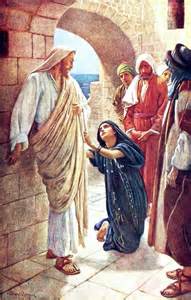
Faith and Grace
The story of the Canaanite woman in the Gospel of Matthew is not a favorite of many because in it, Jesus makes an unmistakable reference to the Canaanite woman as a dog. Some commentaries soften it by saying that Jesus was just teasing her, or perhaps Jesus did not use the term “dog” but another term for “cute puppy”, because cute puppies beg so persistently from their masters. However, in Jesus’ time, the terms “dog” and “swine” were commonly used by Jews for Gentiles, including Canaanites.
Who were the Canaanites? In Genesis 9, after the great flood, Noah and his three sons, Shem, Ham and Japheth came out of the ark. Ham was the father of Canaan. Noah planted a vineyard. He drank the wine, became drunk, and lay naked inside his tent. Ham saw his father’s nakedness; he went outside the tent and told his two brothers. Shem and Japheth took a robe, and holding it on their shoulders, walked backward and covered their father’s nakedness; in doing so, they were careful not to see their father’s shame. When Noah woke up and learned what Ham had done, he cursed Ham’s son: “Cursed be Canaan! The lowest of slaves shall he be to his brothers.” (Genesis 9:25)
The Canaanites were descendants of Canaan and they were scorned by the Israelites, who regarded them as a cursed people. The Israelites also had a long history of armed conflict with the Canaanites; hence, they were also regarded as enemies of Israel. Therefore, when the Canaanite woman persisted in begging for Jesus’ help, Jesus replied, “I was sent only to the lost sheep of the house of Israel” and “It is not right to take the food of the children and throw it to the dogs.” (Matthew 15:24, 26) In this metaphorical statement, ‘children’ represented the Israelites, while ‘dogs’ represented the Gentiles.
But, here is the most important point of the story: Putting aside her dignity, the Canaanite woman humbled herself even more by saying, “Please, Lord, for even the dogs eat the scraps that fall from the table of their masters.” (Matthew 15:27) After that came the surprise ending: Jesus tells her, “O woman, great is your faith! Let it be done for you as you wish.” And her daughter was healed from that hour. (Matthew 15:28)
The story of the Canaanite woman in the Gospel of Matthew is a classic story of faith and grace. The Catechism tells us that faith is a personal adherence of man to God; and at the same time, faith is a free assent to the whole truth that God has revealed. (CCC 150) Despite her religious background, the Canaanite woman adhered to the true God and to the revelation that Jesus is the One He sent; unlike the scribes, the chief priests and the Pharisees, who were the religious leaders of Israel, this Gentile woman believed in Jesus: Not only did she call Jesus, “Lord, Son of David” (cf. Matthew 15:22), she also believed that Jesus had the power to heal her daughter and deliver her from the torments of the demon. The Canaanite woman’s faith resulted in the grace of a miraculous healing for her daughter.
The Catechism also tells us that in faith, the human intellect and the human will cooperate with divine grace. Believing is an act of the intellect, which assents to the divine truth by command of the will, which in turn is moved by God through grace. (CCC 155) Grace is not only the beginning of faith, but more grace results from faith, as shown by the story of the Canaanite woman.
